Intake Manifold BMW X5 2002 E53 M54 Engine Workshop Manual
[x] Cancel search | Manufacturer: BMW, Model Year: 2002, Model line: X5, Model: BMW X5 2002 E53Pages: 48, PDF Size: 2.52 MB
Page 4 of 48
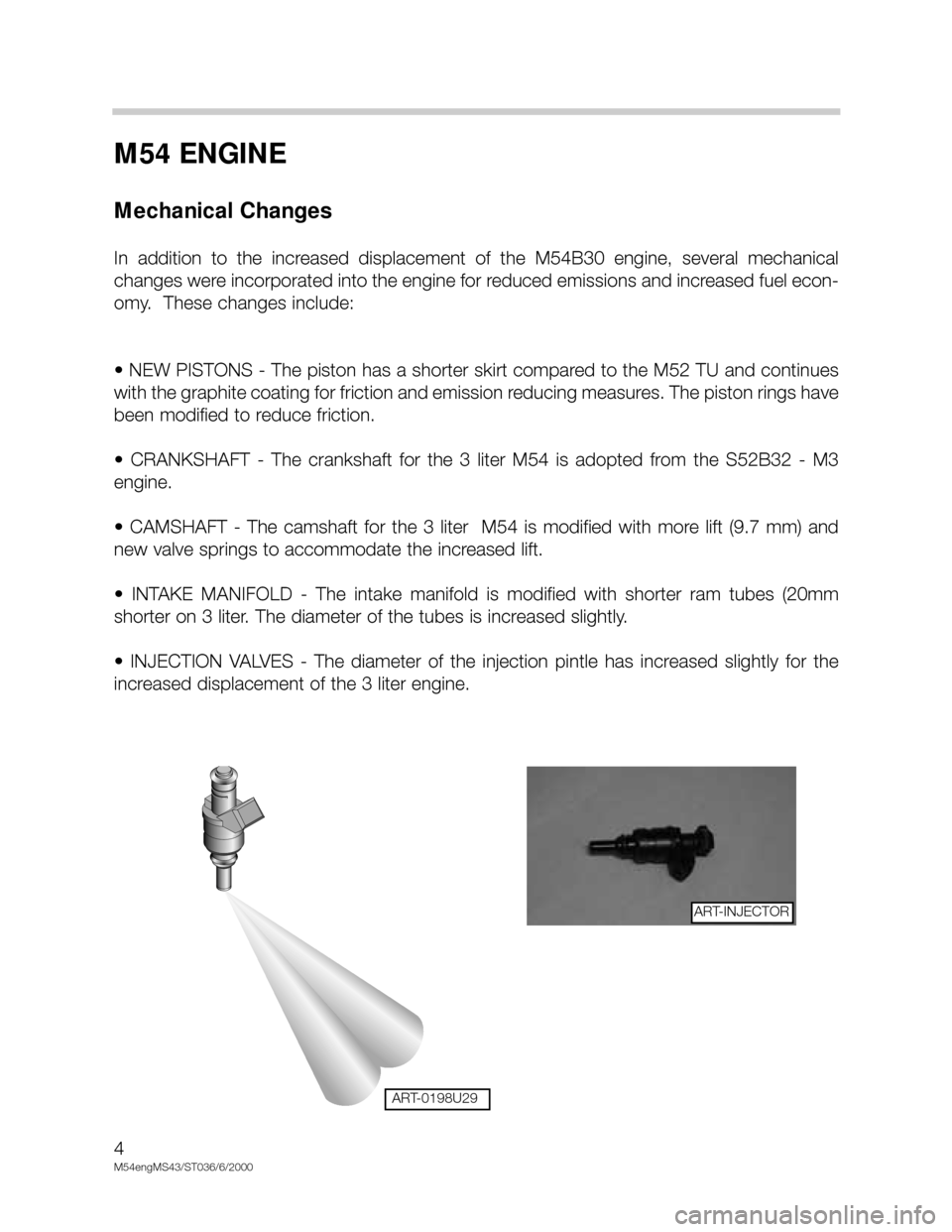
M54 ENGINE
Mechanical Changes
In addition to the increased displacement of the M54B30 engine, several mechanical
changes were incorporated into the engine for reduced emissions and increased fuel econ-
omy. These changes include:
• NEW PISTONS - The piston has a shorter skirt compared to the M52 TU and continues
with the graphite coating for friction and emission reducing measures. The piston rings have
been modified to reduce friction.
• CRANKSHAFT - The crankshaft for the 3 liter M54 is adopted from the S52B32 - M3
engine.
• CAMSHAFT - The camshaft for the 3 liter M54 is modified with more lift (9.7 mm) and
new valve springs to accommodate the increased lift.
• INTAKE MANIFOLD - The intake manifold is modified with shorter ram tubes (20mm
shorter on 3 liter. The diameter of the tubes is increased slightly.
• INJECTION VALVES - The diameter of the injection pintle has increased slightly for the
increased displacement of the 3 liter engine.
4
M54engMS43/ST036/6/2000
ART-0198U29
ART-INJECTOR
Page 5 of 48
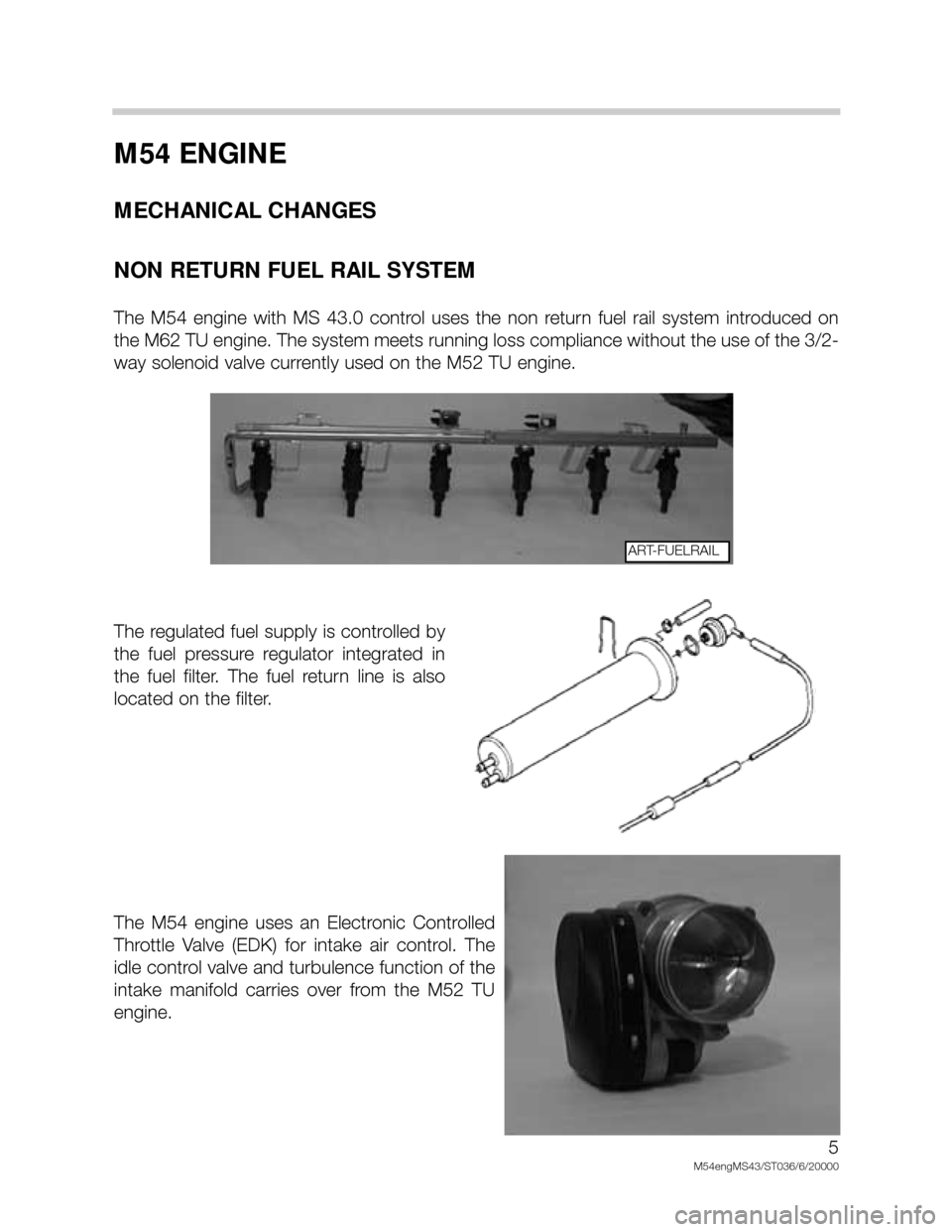
M54 ENGINE
MECHANICAL CHANGES
NON RETURN FUEL RAIL SYSTEM
The M54 engine with MS 43.0 control uses the non return fuel rail system introduced on
the M62 TU engine. The system meets running loss compliance without the use of the 3/2-
way solenoid valve currently used on the M52 TU engine.
The regulated fuel supply is controlled by
the fuel pressure regulator integrated in
the fuel filter. The fuel return line is also
located on the filter.
The M54 engine uses an Electronic Controlled
Throttle Valve (EDK) for intake air control. The
idle control valve and turbulence function of the
intake manifold carries over from the M52 TU
engine.
5
M54engMS43/ST036/6/20000
ART-FUELRAIL
Page 35 of 48
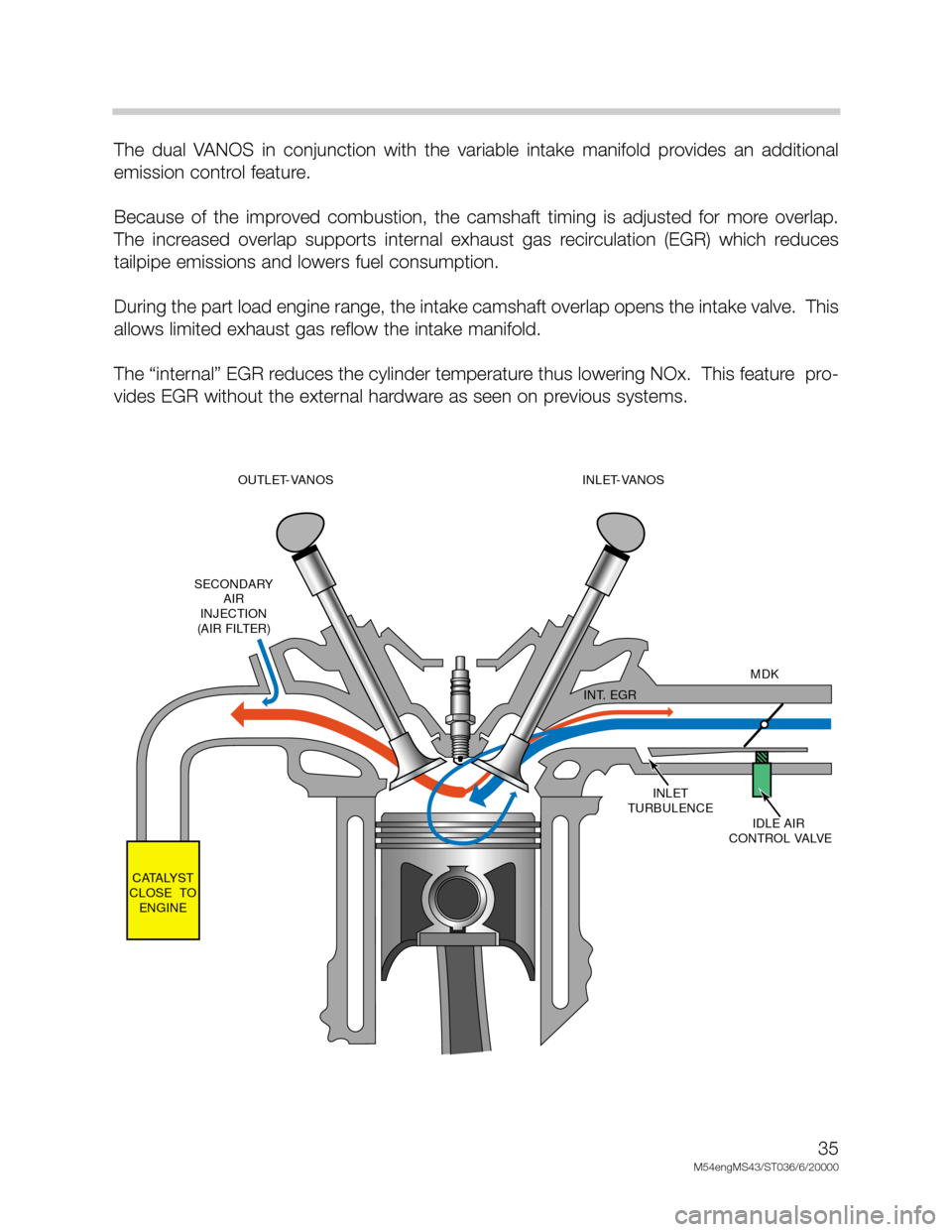
35
M54engMS43/ST036/6/20000
The dual VANOS in conjunction with the variable intake manifold provides an additional
emission control feature.
Because of the improved combustion, the camshaft timing is adjusted for more overlap.
The increased overlap supports internal exhaust gas recirculation (EGR) which reduces
tailpipe emissions and lowers fuel consumption.
During the part load engine range, the intake camshaft overlap opens the intake valve. This
allows limited exhaust gas reflow the intake manifold.
The “internal” EGR reduces the cylinder temperature thus lowering NOx. This feature pro-
vides EGR without the external hardware as seen on previous systems.
INLET
TURBULENCE
IDLE AIR
CONTROL VALVEMDK
INT. EGR
CATALYST
CLOSE TO
ENGINESECONDARY
AIR
INJECTION
(AIR FILTER)OUTLET-VANOS
(228/80-105)INLET-VANOS
(228/80-120)
Page 41 of 48
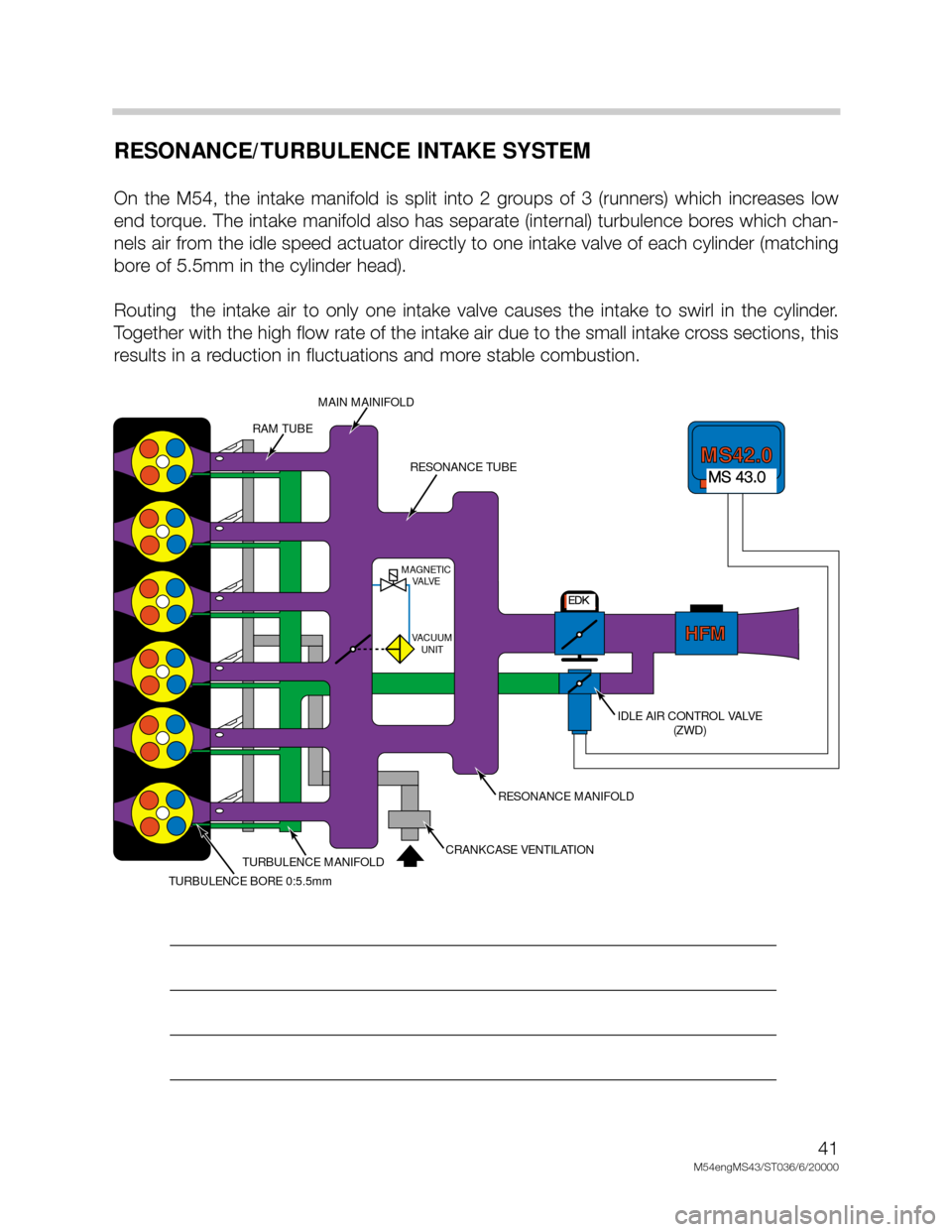
41
M54engMS43/ST036/6/20000
RESONANCE/TURBULENCE INTAKE SYSTEM
On the M54, the intake manifold is split into 2 groups of 3 (runners) which increases low
end torque. The intake manifold also has separate (internal) turbulence bores which chan-
nels air from the idle speed actuator directly to one intake valve of each cylinder (matching
bore of 5.5mm in the cylinder head).
Routing the intake air to only one intake valve causes the intake to swirl in the cylinder.
Together with the high flow rate of the intake air due to the small intake cross sections, this
results in a reduction in fluctuations and more stable combustion.
_________________________________________________________________
_________________________________________________________________
_________________________________________________________________
_________________________________________________________________
MDK
HFMHFM
MAGNETIC
VALVE
VACUUM
UNIT
MS42.0MS42.0
RAM TUBE
MAIN MAINIFOLD
RESONANCE TUBE
IDLE AIR CONTROL VALVE
(ZWD)
RESONANCE MANIFOLD
CRANKCASE VENTILATIONTURBULENCE MANIFOLD
TURBULENCE BORE 0:5.5mm
MS 43.0
EDK
Page 42 of 48
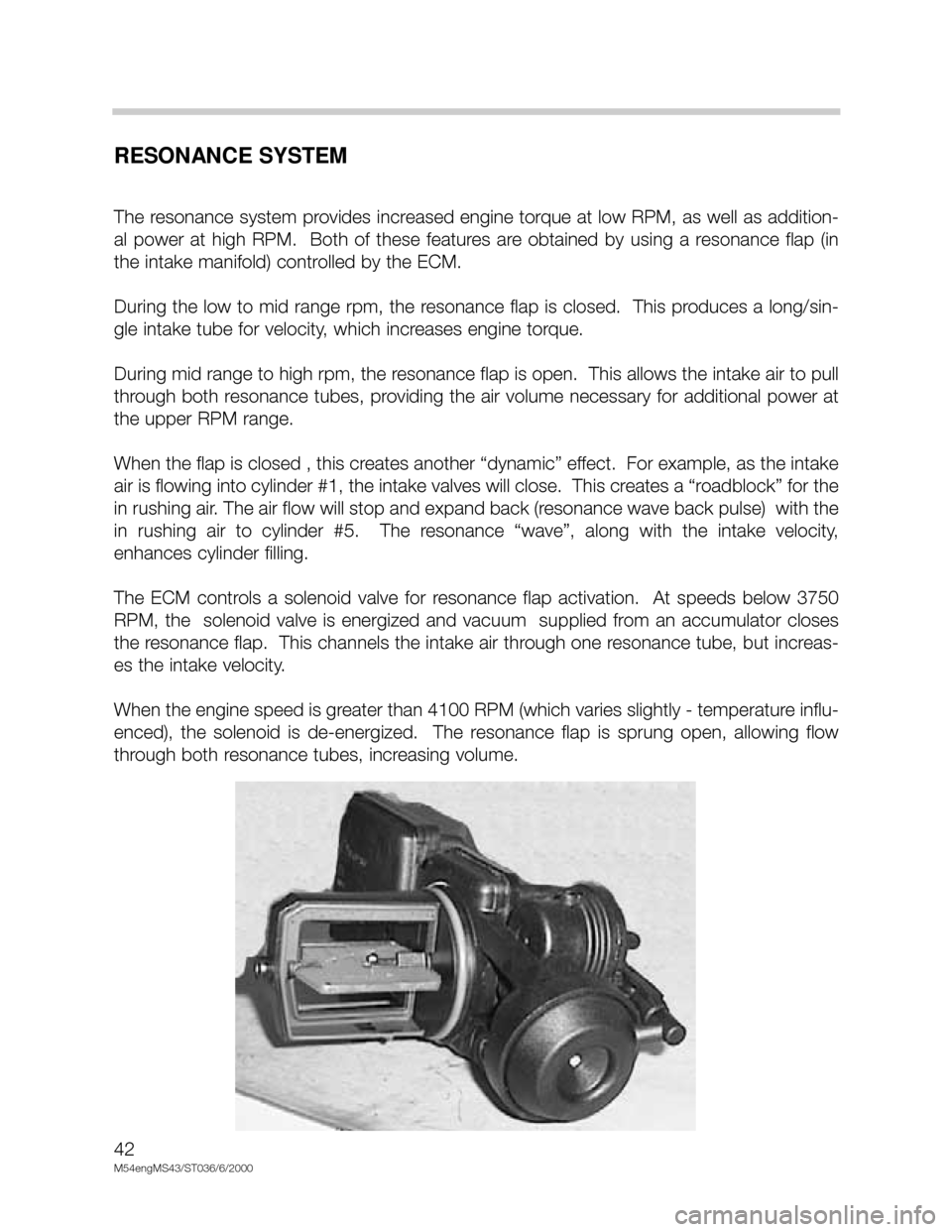
42
M54engMS43/ST036/6/2000
RESONANCE SYSTEM
The resonance system provides increased engine torque at low RPM, as well as addition-
al power at high RPM. Both of these features are obtained by using a resonance flap (in
the intake manifold) controlled by the ECM.
During the low to mid range rpm, the resonance flap is closed. This produces a long/sin-
gle intake tube for velocity, which increases engine torque.
During mid range to high rpm, the resonance flap is open. This allows the intake air to pull
through both resonance tubes, providing the air volume necessary for additional power at
the upper RPM range.
When the flap is closed , this creates another “dynamic” effect. For example, as the intake
air is flowing into cylinder #1, the intake valves will close. This creates a “roadblock” for the
in rushing air. The air flow will stop and expand back (resonance wave back pulse) with the
in rushing air to cylinder #5. The resonance “wave”, along with the intake velocity,
enhances cylinder filling.
The ECM controls a solenoid valve for resonance flap activation. At speeds below 3750
RPM, the solenoid valve is energized and vacuum supplied from an accumulator closes
the resonance flap. This channels the intake air through one resonance tube, but increas-
es the intake velocity.
When the engine speed is greater than 4100 RPM (which varies slightly - temperature influ-
enced), the solenoid is de-energized. The resonance flap is sprung open, allowing flow
through both resonance tubes, increasing volume.
Page 45 of 48
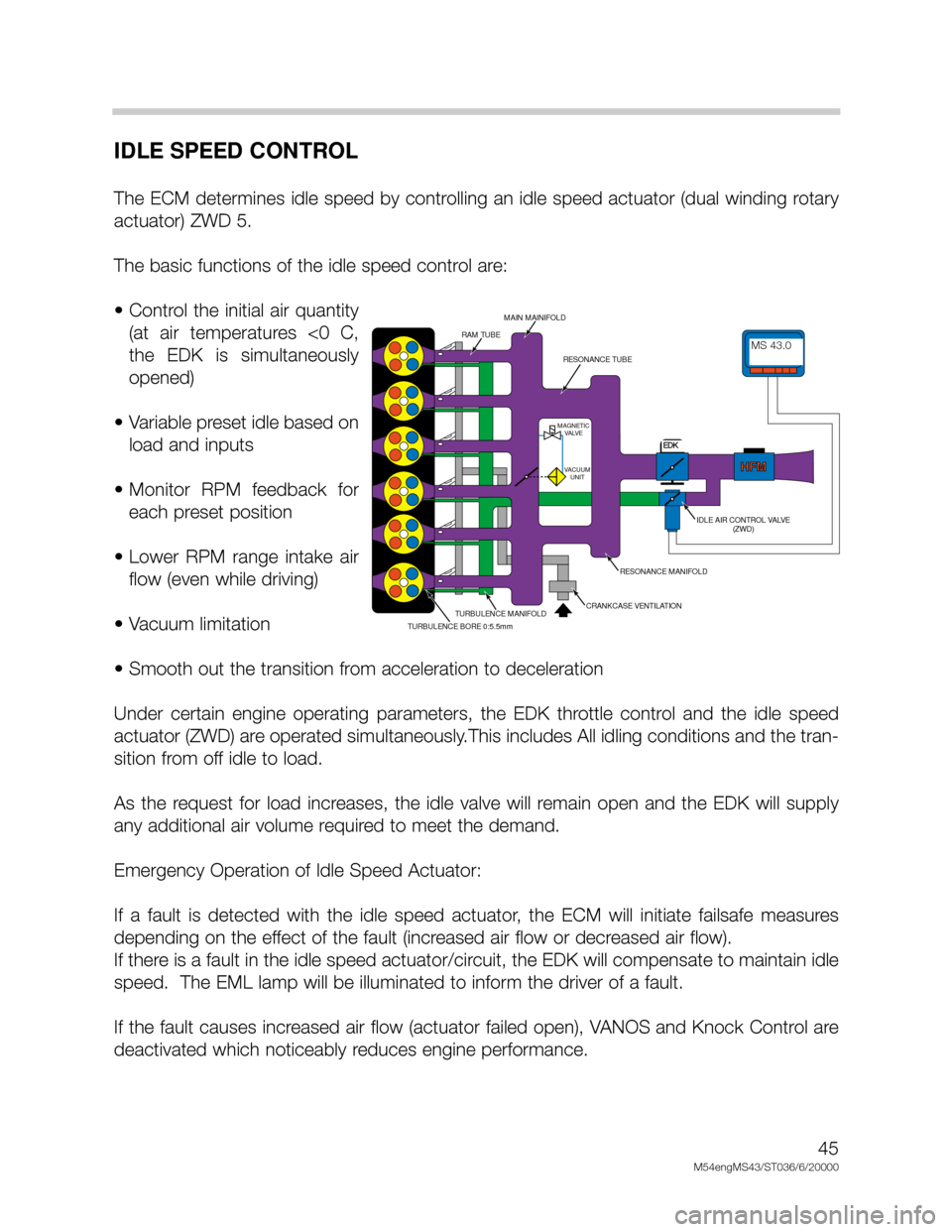
45
M54engMS43/ST036/6/20000
IDLE SPEED CONTROL
The ECM determines idle speed by controlling an idle speed actuator (dual winding rotary
actuator) ZWD 5.
The basic functions of the idle speed control are:
• Control the initial air quantity
(at air temperatures <0 C,
the EDK is simultaneously
opened)
• Variable preset idle based on
load and inputs
• Monitor RPM feedback for
each preset position
• Lower RPM range intake air
flow (even while driving)
• Vacuum limitation
• Smooth out the transition from acceleration to deceleration
Under certain engine operating parameters, the EDK throttle control and the idle speed
actuator (ZWD) are operated simultaneously.This includes All idling conditions and the tran-
sition from off idle to load.
As the request for load increases, the idle valve will remain open and the EDK will supply
any additional air volume required to meet the demand.
Emergency Operation of Idle Speed Actuator:
If a fault is detected with the idle speed actuator, the ECM will initiate failsafe measures
depending on the effect of the fault (increased air flow or decreased air flow).
If there is a fault in the idle speed actuator/circuit, the EDK will compensate to maintain idle
speed. The EML lamp will be illuminated to inform the driver of a fault.
If the fault causes increased air flow (actuator failed open), VANOS and Knock Control are
deactivated which noticeably reduces engine performance.
MDK
HFMHFM
MAGNETIC
VALVE
VACUUM
UNIT
MS42.0MS42.0
RAM TUBE
MAIN MAINIFOLD
RESONANCE TUBE
IDLE AIR CONTROL VALVE
(ZWD)
RESONANCE MANIFOLD
CRANKCASE VENTILATIONTURBULENCE MANIFOLD
TURBULENCE BORE 0:5.5mm
MS 43.0
EDK